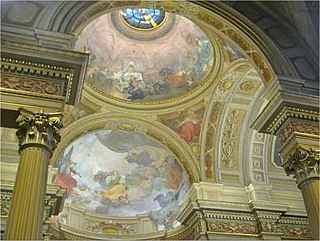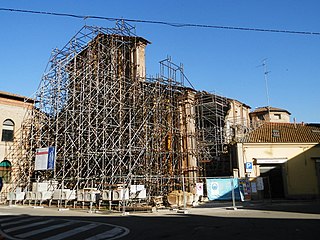
The Church of the Gesù is the mother church of the Society of Jesus (Jesuits), a Catholic religious order. Officially named Chiesa del Santissimo Nome di Gesù, its façade is "the first truly baroque façade", introducing the baroque style into architecture. The church served as a model for innumerable Jesuit churches all over the world, especially in Central Europe and in Portuguese colonies. Its paintings in the nave, crossing, and side chapels became models for art in Jesuit churches throughout Italy and Europe, as well as those of other orders. The Church of the Gesù is located at the Piazza del Gesù in Rome, and is one of the great 17th century preaching churches built by Counter-Reformation orders like the Jesuits in the Centro Storico.

Carlo Cignani was an Italian painter. His innovative style referred to as his 'new manner' introduced a reflective, intimate mood of painting and presaged the later pictures of Guido Reni and Guercino, as well as those of Simone Cantarini. This gentle manner marked a break with the more energetic style of earlier Bolognese classicism of the Bolognese School of painting.

Santa Maria dei Miracoli and Santa Maria di Montesanto are two churches in Rome.

The Basilica of San Domenico is one of the major churches in Bologna, Italy. The remains of Saint Dominic, founder of the Order of Preachers (Dominicans), are buried inside the exquisite shrine Arca di San Domenico, made by Nicola Pisano and his workshop, Arnolfo di Cambio and with later additions by Niccolò dell'Arca and the young Michelangelo.

Filippo Barigioni (1690–1753) was an Italian sculptor and architect working in the Late Baroque tradition.

Santa Maria in Vallicella, also called Chiesa Nuova, is a church in Rome, Italy, which today faces onto the main thoroughfare of the Corso Vittorio Emanuele and the corner of Via della Chiesa Nuova. It is the principal church of the Oratorians, a religious congregation of secular priests, founded by St Philip Neri in 1561 at a time in the 16th century when the Counter Reformation saw the emergence of a number of new religious institutes such as the Jesuits, the Theatines, and the Barnabites. These new congregations were responsible for several great preaching churches built in the Centro Storico, the others being Sant'Andrea della Valle (Theatines), San Carlo ai Catinari (Barnabites), and The Gesù and Sant'Ignazio (Jesuits).

The Church and Convent of the Girolamini or Gerolamini is a church and ecclesiastical complex in Naples, Italy. It is located directly across from the Cathedral of Naples on via Duomo. The facade is across the homonymous piazza and street from Santa Maria della Colonna. It is one block west of Via Duomo.

San Girolamo della Carità is a church in Rome, Italy, located near the Palazzo Farnese and Campo de' Fiori.

Jacopo Zoboli, also known by Giacomo, was an Italian painter of the Baroque style.

San Procolo is an early Gothic-style, Roman Catholic church and former monastery-hospital located on Via Massimo D'Azeglio #52 in central Bologna, region of Emilia Romagna, Italy.

The Oratory of San Filippo Neri in Bologna is a restored late-Baroque religious structure in central Bologna. It is located on Via Manzoni. The Oratory was constructed from the sacristy of the adjacent church of the Madonna di Galliera. This church is now called Chiesa dei Filippini Madonna di Galliera e Filippo Neri.

The church of Santa Maria Maddalena is found in central Bologna, Italy.

Saint Mary of the PeaceChurch is a Baroque-style, Roman Catholic church located on Via Pace in central Brescia, region of Lombardy, Italy. The church belongs to the Oratorians.

San Benedetto is a Roman Catholic church in central Bologna. Founded in the 12th century, the church now has facade (1606) designed by Giovanni Battista Ballerini. The Facade was rotated 180 degrees in 1892; it once faced Via Galliera, and now faces Via dell'Indipendenza. The interior contains works by Giacomo Cavedoni, Alessandro Tiarini, Cesare Aretusi, Lucio Massari, Ercole Procaccini il Vecchio, Ubaldo Gandolfi, and a sculpture by Angelo Gabriello Piò.

The Complesso di San Firenze is a 17th-century Baroque-style building, consisting of a church, palace, and former oratory, located on the southeast corner of the saucer-shaped piazza of San Firenze, located in the quartiere of Santa Croce in central Florence, region of Tuscany, Italy. The buildings were commissioned by the Oratorians of Saint Philip Neri.
Santa Maria delle Muratelle, or Santa Maria Annunziata delle Muratelle, is a 17th-century Roman Catholic church located on Via Saragozza #2 in Bologna, region of Emilia Romagna, Italy.
San Giuseppe is a former-Roman Catholic church and former convent in Sassuolo, Region of Emilia Romagna, Italy.

The church of San Francesco is a church located in Mirandola, in the province of Modena, Italy.

San Pietro is an ancient Roman Catholic church and former monastery located on piazza San Pietro in central Gubbio, region of Umbria, in Italy. The church which displays architectural elements from many centuries, from Romanesque to the Renaissance, as well as housing prominent artworks; the monastery now houses the civic Biblioteca Comunale Sperelliana.

San Filippo Neri, also called the Chiesa dell’Immacolata Concezione is a Baroque-style, Roman Catholic church located located on Via Vittorio Emenuele II # 61 in the town of Chieri, in the Metropolitan City of Turin, region of Piedmont, Italy. The adjacent seminary is now a museum called Centro Visite Don Bosco, recalling the saint's seminary training here during the early 19th century. The church is part of the parish of the Collegiate Church of Santa Maria della Scala, Chieri.





















